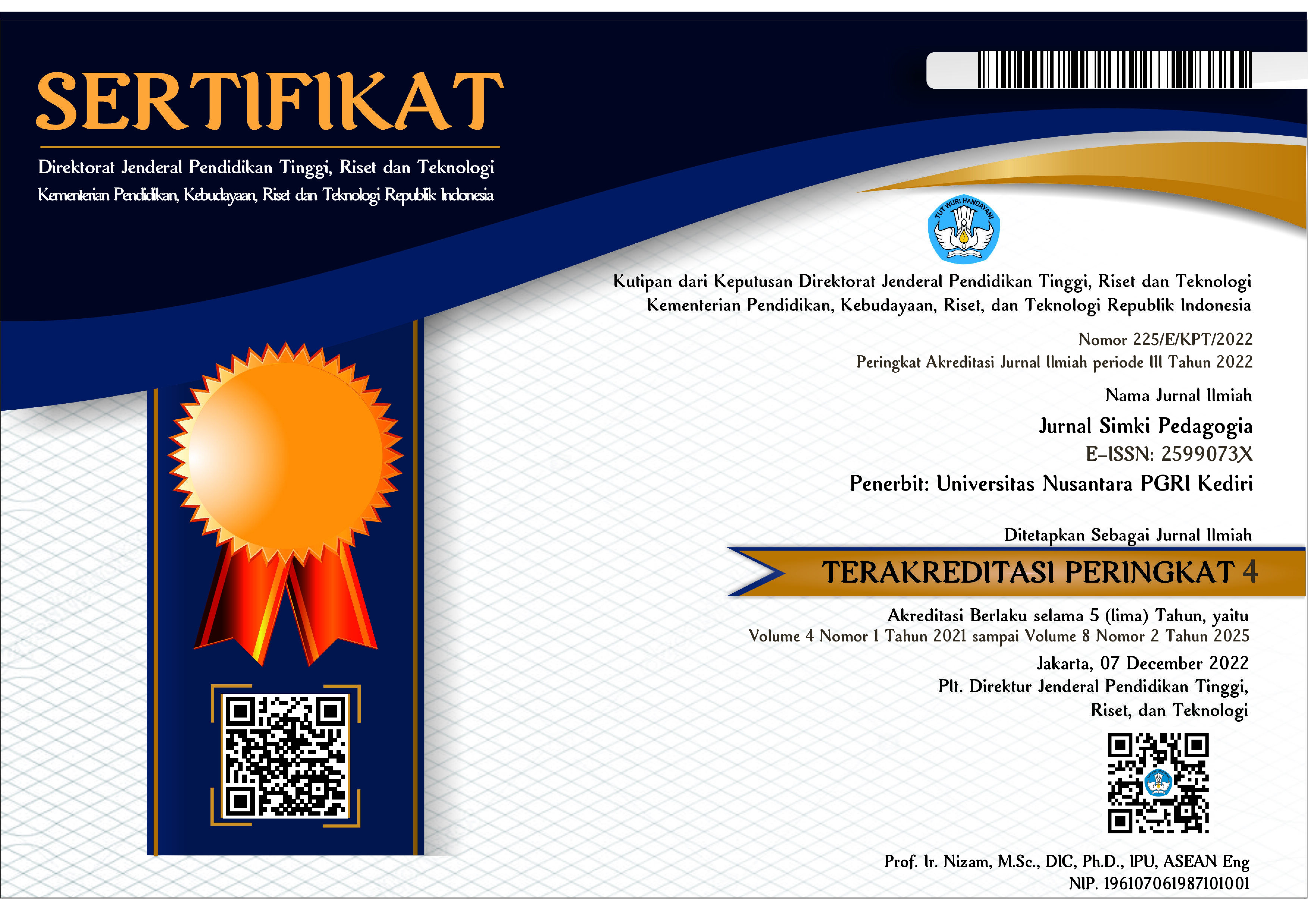Pengembangan Desain Model Flipped Learning dalam Pembelajaran Daring
 Abstract views: 438
,
Abstract views: 438
,
 PDF (Bahasa Indonesia) downloads: 320
PDF (Bahasa Indonesia) downloads: 320
Abstract
This research is a development research (R&D) which aims to develop a learning design using the Flipped Learning model in valid online conditions in the Educational Evaluation Engineering course. The development model used is the ADDIE model with reference to the learning design according to the philosophy of flipped learning. The development of Flipped Learning learning designs in online conditions produces several learning tools, namely 1) Guidelines for implementing Flipped Learning in online conditions, 2) Semester Lecture Plans for the Education Evaluation Techniques course using the Flipped Learning learning model, as well as Lecture Sheets for 16 meetings with Flipped Learning model. After being validated, a validation value of 3.36 was obtained from a scale of 4 and was stated to be very valid and could be used as a learning tool in educational evaluation techniques courses.
Downloads
References
Abdul Latif, S. W., Matzin, R., Jawawi, R., Mahadi, M. A., Jaidin, J. H., Mundia, L., & Shahrill, M. (2017). Implementing the Flipped Classroom Model in the Teaching of History. Journal of Education and Learning (EduLearn), 11(4), 374–381. https://doi.org/10.11591/edulearn.v11i4.6390
Al-Samarraie, H., Shamsuddin, A., & Alzahrani, A. I. (2020). A flipped classroom model in higher education: a review of the evidence across disciplines. In Educational Technology Research and Development (Vol. 68, Issue 3). Springer US. https://doi.org/10.1007/s11423-019-09718-8
Anugrah, A., Ibrahim, N., & Sukardjo, M. (2021). How Flipped Classroom Helps the Learning in the Times of Covid-19 Era? JTP - Jurnal Teknologi Pendidikan, 22(3), 151–158. https://doi.org/10.21009/jtp.v22i3.17555
Bintari Kartika Sari. (2017). Desain Pembelajaran Model ADDIE dan Impelentasinya dengan Teknik Jigsaw. Prosiding Seminar Nasional Pendidikan : Tema “Desain Pembelajaran Di Era ASEAN Economic Community (AEC) Untuk Pendidikan Indonesia Berkemajuan ,” 94–96, 87–102. http://eprints.umsida.ac.id/432/
Chaeruman, U. A., Wibawa, B., & Syahrial, Z. (2020). Development of an Instructional System Design Model as a Guideline for Lecturers in Creating a Course Using Blended Learning Approach. IJIM, 14(14), 164–181. https://doi.org/10.3991/ijim.v14i14.14411
Fazal, M., & Navarrete, C. (2020). Flipped Learning in Online Courses: Challenges and Possibilities. INTED2020 Proceedings, 1(March), 139–139. https://doi.org/10.21125/inted.2020.0083
Hutauruk, A., & Sidabutar, R. (2020). Kendala pembelajaran daring selama masa pandemi di kalangan mahasiswa pendidikan matematika: Kajian kualiatatif deskriptif. Journal of Mathematics Education and Applied, 02(01), 45–51. https://doi.org/10.36655/sepren.v2i1.364
Kartika, R. (2020). Analisis Faktor Munculnya Gejala Stres Pada Mahasiswa Akibat Pembelajaran Jarak Jauh Di Masa Pandemi Covid-19. Edukasi Dan Teknologi, 1(2), 107–115. https://doi.org/10.31234/osf.io/nqesb
Livana, Mubin, & Basthomi, Y. (2020). Penyebab Stres Mahasiswa Selama Pandemi Covid-19. Jurnal Ilmu Keperawatan Jiwa, 3(2), 203–208.
Maulana, H. A. &, & Iswari, R. D. (2020). Analisis Tingkat Stres Mahasiswa Terhadap Pembelajaran Daring Pada Mata Kuliah Statistik Bisnis di Pendidikan Vokasi. Jurnal Ilmiah Kependidikan, 14(1), 17–30. http://dx.doi.org/10.30595/jkp.v14i1.8479
McLaughlin, J. E., Roth, M. T., Glatt, D. M., Gharkholonarehe, N., Davidson, C. A., Griffin, L. M., Esserman, D. A., & Mumper, R. J. (2014). The flipped classroom: A course redesign to foster learning and engagement in a health professions school. Academic Medicine, 89(2), 236–243. https://doi.org/10.1097/ACM.0000000000000086
Nouri, J. (2016). The flipped classroom: for active, effective and increased learning – especially for low achievers. International Journal of Educational Technology in Higher Education, 13(1). https://doi.org/10.1186/s41239-016-0032-z
Pawicara, R., & Conilie, M. (2020). Analisis Pembelajaran Daring Terhadap Kejenuhan Belajar Mahasiswa Tadris Biologi Iain Jember di Tengah Pandemi Covid-19. ALVEOLI: Jurnal Pendidikan Biologi, 1(1), 29–38. https://doi.org/10.35719/alveoli.v1i1.7
Sams, A., & Bergmann, J. (2011). Flipping the cussroom. Educational Horizons, 90(1).
Talbert, R., & Bermann, J. (2017). A Guide for Higher Education Faculty. Stylus Publishing, LLC.
Van Vliet, E. A., Winnips, J. C., & Brouwer, N. (2015). Flipped-class pedagogy enhances student metacognition and collaborative-learning strategies in higher education but effect does not persist. CBE Life Sciences Education, 14(3), 1–10. https://doi.org/10.1187/cbe.14-09-0141
Zainuddin, Z., & Halili, S. H. (2016). Flipped classroom research and trends from different fields of study. International Review of Research in Open and Distance Learning, 17(3), 313–340. https://doi.org/10.19173/irrodl.v17i3.2274
Copyright (c) 2023 Arini Rahmadana, Oki Sanda Agnesa

This work is licensed under a Creative Commons Attribution 4.0 International License.

Jurnal Simki Pedagogia : https://jiped.org/index.php/JSP/index is licensed under a Creative Commons Attribution 4.0 International License.
















